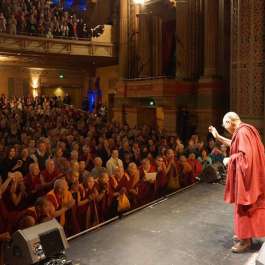
December heralded good news for Venerable Hin Hung’s research team at the University of Hong Kong’s (HKU) Centre of Buddhist Studies (CBS): the peer-reviewed journal Mindfulness had accepted their paper, “A Randomized Controlled Trial of Awareness Training Program (ATP), a group-based Mahayana Buddhist Intervention,” for publication. The paper was also the subject of Ven. Hin Hung and research partner and PhD candidate Bonnie Wu’s presentation at a symposium on Buddhist counseling, held in November last year. The paper’s acceptance was an important step in the ongoing conversation between Buddhist practitioners and counseling specialists as its results—at least in the experimental setting—validated several important premises of the ATP.
ATP is a group therapy that consists of three-hour workshops over six weeks (each with their own theme), and a weekend retreat. Ven. Hin Hung defines ATP as a textually aligned program based on a Mahayana scripture—specifically the Sandhinirmochana Sutra, a Yogacara (consciousness-only or “mind school”) scripture, which makes ATP internally coherent in theory and practice. The specific pedagogy of ATP follows three Buddhist forms of wisdom: wisdom acquired from learning through lectures, wisdom acquired from thinking via discussion groups, experiential learning activities, and wisdom gained by direct experience (meditation and mantras as outlined by the Sandhinirmochana Sutra).
According to Ven. Hin Hung and Bonnie Wu, these premises were foundational to ensuring a sound approach that would realize the Buddhist vision of saving all sentient beings from suffering. For a bodhisattva, suffering is not something to be eliminated, but a means to develop compassion, and through wisdom and compassion a bodhisattva acquires the skillful means to meet with pastoral challenges while remaining in samsara to liberate others. “For us it was important to develop a Buddhist model that, once applied, would not lead its practitioners to suffer from cognitive dissonance,” said Ven. Hin Hung.
“The theory must be aligned with praxis; any methodology that claims to be inspired by Buddhism should be congruent with a Buddhist text. Now, we have counseling models based on Early Buddhism, such as the Four Noble Truths.” The model of Dharma Therapy, which Ven. Hin Hung developed, follows more the lines of Early Buddhism. “However, Mahayana Buddhism has so many different scriptures, schools, and lines of philosophical inquiry that we needed to choose a sutra that could, in our assessment, provide a solid thread connecting its theory and praxis for patients/clients. For this our team chose the Sandhinirmochana Sutra due to its relatively ‘complete’ ecosystem of logic and internal coherence. It argues that attachment is the result of an illusory concept of “self” arising from a delusive understanding of the world.Simply put, it has one model of meditation that is persuasive and workable, regardless of its sub-models and interpretations.”
Bonnie Wu and Ven. Hin Hung contrasted this (relative) simplicity with scriptures like the Heart Sutra and the Diamond Sutra, with meditation models that are not very clear. “What are we cultivating non-attachment to [and therefore revealing the essenceless-ness of] here?” asked Ven. Hin Hung. “Three primary things: conceptual thought or proliferations, dependently originated phenomenon [seeing them as karmic composites of the Five Aggregates], and any notion of inherent essence itself.”
He also pointed out that while insight into essenceless-ness and compassion might initially run separate, parallel lines, they eventually intersect. Non-attachment helps us to develop compassion because we see that sentient beings’ suffering is intimately wound up in their attachments to the things mentioned in the Sandhinirmochana Sutra, and dwelling in compassion feeds into the desire to assist in the liberation of these suffering beings.
The initial group of participants of the study consisted out of working adults, aged 30–60, who had self-reported at least moderate levels of stress in work, family, relationships, interpersonal ties, finances, health, or social environment. Many other factors were at play in the randomized-controlled trial (RCT) and the succeeding calculations involving the analysis of “wisdom in the form of nonattachment” as the mediating factor of the outcome measures. Nevertheless, the results indicate that ATP effectively improves these working adults’ perceived levels of stress (PSS), sense of coherence (SOC), and psychological wellbeing (GHQ). Importantly and uniquely, the wisdom of non-attachment (NAS) served as the key component to mediate the improvement of levels of PSS, SOC, and GHQ. Therapeutic improvements were maintained throughout a three-month follow-up.
Further neuroscientific experiments were conducted to investigate whether ATP had any priming effect (compassion) on a person’s neutral response to viewing negative and neutral pictures. In an 85-strong group of participants (ATP group 42 and control group 43), ATP training (by inducing more prefrontal lobe activity) seemed to be able to effectively modulate participants’ emotions when viewing negative or distressing images. “It’s about handling emotions and becoming more familiar with your inner world. Can you observe the grief that you’re experiencing? Can you observe yourself when you’re acting out in a temper? The same questions apply when you feel positive emotions,” concludes Ven. Hin Hung.
So far, the research looks encouraging, although more experiments need to be conducted before ATP can gain more conclusive credentials in the Buddhist counseling world. “In some ways, we are really building EQ, and as Daniel Goleman wrote many years ago, you can nourish and develop EQ. While it is thought that IQ is hardwired from birth, but EQ is very much malleable. One could see ATP as an effective means through which EQ is upgraded, at least for working adults that report experiencing stress. We must replicate this data, and only then can we make bolder claims about the efficacy of ATP.” For now, however, it seems that the meditation techniques and philosophy found within the Sandhinirmochana Sutra possess the potential of contributing to scripture-based model of group counseling for working adults.
See more












